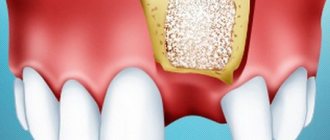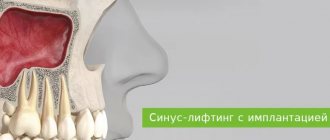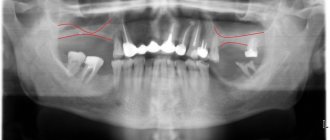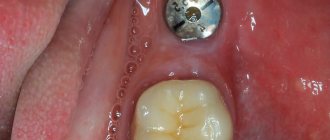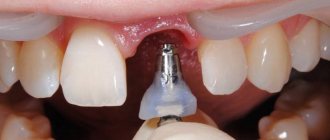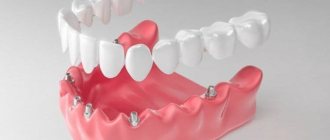More than 7 million people around the world have received dental implants to restore one, several or all teeth. Dentures on implants are a reliable, safe and well-researched method of restoring the aesthetics and functionality of the dentition: you can smile beautifully again and eat your favorite food without restrictions.
For those planning to install implants, we have prepared answers to the following questions:
Contraindications for installing titanium rods
Does it hurt during implant placement?
Installation stages (step by step with deadlines)
What not to do after installation?
What complications can there be after implantation?
Guarantees for implant installation
Contraindications
| Absolute (operation impossible) | Relative (the operation is temporarily postponed) |
|
|
Diagnosis before surgery
To properly plan the procedure and select the optimal one, it is necessary to undergo diagnostics. An important step is to refer the patient for a computed tomography (CT) scan - this way the doctor will have a complete picture of the structure of the upper jaw and maxillary sinus, as well as the exact measurements of the thickness of the bone and sinus membrane. Additionally, blood tests are required, at a minimum - general clinical and to determine glucose levels. If certain diseases (endocrine or cardiovascular) are detected or present, you will need to consult a specialized specialist and prescribe therapy.
Does it hurt during implantation?
All procedures are carried out under local anesthesia, so the patient does not experience any painful sensations - he only feels the mechanical work of the doctor in the mouth, as during conventional dental treatment. In fact, the manipulations performed when installing an artificial root are less invasive and traumatic than when removing a tooth.
If you are very worried and are terrified of the upcoming operation, the clinic may offer implantation under sedation - in a relaxed state, but in full consciousness. The patient is given drugs that put him into a light sleep and he ceases to experience anxiety.
Stages and deadlines
1. Initial appointment (up to 20 minutes).
The implant surgeon gets to know the patient. Visually examines the oral cavity, assessing the current health of teeth and gums. To exclude the presence of contraindications and analyze the possible risks of complications after implantation, the doctor collects an anamnesis - information about the patient’s living conditions, diseases, bad habits, pharmaceuticals taken, etc. Answers any questions that may arise.
In what cases is it recommended to undergo tests before implantation?
Additional examination is necessary if the patient:
- has a chronic disease;
- undergoing any treatment;
- in the last 1-2 months, suffered from a serious illness or underwent surgery.
2. Comprehensive hardware diagnostics (up to 30 minutes).
Includes:
- Sight shot
. Necessary for assessing the condition of teeth located adjacent to the implant installation site. Detects inflammatory processes at the apex of teeth, hidden fractures/root injuries. Helps assess the quality of installed fillings (if any). Eliminates the risk of infection from neighboring teeth getting into the socket when an artificial root is implanted. - Panoramic photo (orthopantomogram)
. This three-dimensional image allows you to visualize the upper and lower jaws in an expanded plane. OPTG helps the doctor give an initial assessment of the condition of each tooth, its canals and roots, periodontium, maxillary sinuses, sinuses and other structures of the dental system. - CT (computed tomography)
. Allows you to study in detail the required area of the jaw in any plane at the required angle. Reveals hidden inflammatory and pathological processes in the periodontium. Helps to select the optimal dimensions of the titanium rod, as well as the installation location. Eliminates damage to the maxillary/mandibular nerve and blood vessels during implant installation. Provides important information for 3D modeling of the surgical process.
3. Computer modeling (2-3 days).
Three-dimensional visualization allows the implant surgeon to calculate and see the result of treatment before it begins. The software helps the doctor determine the optimal locations for installing implants, taking into account the density and volume of bone tissue, select a titanium rod model, and calculate the angle and depth of implantation. The human factor is excluded, the result of implantological treatment is calculated with high accuracy.
4. Preparation (sanitation) of the oral cavity.
Before implantation, it is important to carry out professional dental hygiene (cleaning from plaque and tartar), eliminate existing inflammatory foci, and cure dental diseases identified during diagnosis (caries, pulpitis, etc.).
Jaw implantation using All-on-4 or All-on-6 technology also requires the preliminary removal of existing teeth, since a complete fixed prosthesis of 12 or 14 crowns is installed.
5. Osteoplasty.
If there is insufficient bone tissue volume, before installing a titanium rod, one of the following methods is used to build it up:
- Alveolar ridge clefting
. The doctor makes a cut into the alveolar process (the part of the jaw into which titanium screws are implanted) and increases its thickness using artificial bone material or graft. Installation of the implant is possible after 4-6 months. - Guided bone regeneration
. During the operation, the doctor places a synthetic bone analogue into the jawbone and covers it with a protective membrane. The patient's blood plasma is used to stimulate bone tissue growth. Implantation is possible in 3-6 months. - Sinus lift
. The volume of bone tissue in the area of the maxillary sinuses increases. There are open (more extensive surgery used for severe bone atrophy) and closed sinus lift (less invasive, with a slight lack of bone height).
Our clinic uses Straumann Roxolid implants, which allow us to avoid bone grafting in 95% of clinical situations, both when restoring one tooth and during total prosthetics of a toothless jaw!
6. Surgery (15 minutes).
Under local anesthesia, the doctor makes an incision in the gum and lifts flaps to gain access to the jawbone.
Then he prepares the implantation bed by drilling a hole of the required depth in the bone. After checking the depth of the canal with special tools, the implantologist bores it to the required width.
A titanium rod is implanted into the resulting hole. Its model, length and thickness are selected at the 3D modeling stage.
The implant is closed for 2-6 days with a plug, which protects the artificial root from microbes and mechanical influences.
The gum is sutured, closing the temporary plug.
On days 3-7 after implantation, the sutures are removed and an abutment is installed.
7. Orthopedics.
It takes place in two stages. At the first visit, an impression is taken within 20-30 minutes, on the basis of which a temporary crown will be made in the dental laboratory. At the second visit (after 2-3 weeks, depending on the clinical picture), the prosthesis is fixed to the abutment (duration - up to half an hour).
Differences between closed and open sinus lift
An alternative to an open sinus lift is a closed technique, in which the bottom of the maxillary sinus is lifted through the bed for the future implant. Bone material is introduced into the resulting space between the Schneiderian membrane and the bone itself. An open sinus lift is more invasive: an incision is made in the side of the jaw, the gums are pulled back, and then a small hole is drilled through which the doctor gains access to the maxillary sinus. Based on first impressions, many may think that closed sinus lift is an easy and safe technique, but this is not so. The operation is indeed less invasive, but at the same time more risky. The manipulations are carried out almost blindly, so the risk of damage to the membrane of the maxillary sinus increases.
Implant installation methods
Installing implants allows you to replace missing teeth with new ones that are practically no different from natural ones. Today, there are several main options and ways to install an implant.
Classic implantation
Classical implantation allows you to insert implants in any quantity, even in the absence of teeth in the oral cavity. This process is very lengthy, however, in the end it gives an excellent result. The chewing function and aesthetics of the smile are completely restored. At the first stage of implant installation, artificial roots (the basis of the implants) are implanted into the bone tissue. Then the abutments (support for the crown) are implemented, and only after that it becomes possible to place a dental implant.
One-stage implantation - we will place the implant immediately after tooth extraction
In some cases, an implant can be installed immediately after tooth extraction, without waiting for the tissue to heal. This option allows you to prevent bone tissue atrophy, however, the operation can be performed only in the absence of any acute diseases of the teeth and gums in the patient.
Express implantation
In the case of express implantation, the implant and crown can be installed immediately after it is implanted into the bone. Place an implant
This method is possible provided that one or more teeth located at a distance from each other are restored. A combination of express implantation with other methods is often practiced, provided that express is used for the front teeth. It is possible to place a dental implant using the express method, provided that inflammatory diseases in the patient’s oral cavity have been treated, and there is no need to build up bone in the place of the missing tooth.
Recommendations after implant installation
- During the first 2-3 hours after surgery, eating is strictly not recommended. What happens if you neglect this? Disastrous consequences include: sutures coming apart, infection of the titanium rod installation site, biting the tongue or cheek.
- On the day of surgery, you do not need to brush your teeth or rinse your mouth. Starting from the second day, you can clean them, but with a soft brush. It is better not to touch the operated area. You can also rinse your mouth with an antiseptic solution after eating, but very gently.
- For the first two to three days, you should strictly not consume hot/cold food or drinks. It is recommended to exclude sour and spicy foods from the diet. You can eat broths, yogurt, and pureed foods.
- For 2-4 weeks, avoid air travel, saunas, increased physical activity, and hypothermia. Otherwise, the risk of implant rejection increases.
- Completely stop smoking and drinking alcoholic beverages for at least five days. During the period of osseointegration of implants (3-6 months), reduce the number of cigarettes smoked to a minimum.
Compliance with the following rules will not only help shorten the rehabilitation period, but will also minimize the risk of complications.
Recommendations from specialists on behavior in the postoperative period
Following certain rules after surgery is mandatory. Otherwise, implant rejection and infection of the surgical wound are possible. Doctors strongly recommend that for a month after a sinus lift you do not fly on an airplane, do diving, sports, heavy physical labor, or visit the pool, bathhouse, or sauna. In the first days, you should be especially careful about sneezing and coughing. This must be done as carefully as possible. In the first month after surgery, it is necessary to exclude cold, hot, hard and spicy foods from the diet. You should not drink alcohol or smoke. Only impeccable adherence to medical instructions can prevent unwanted complications.
The network of dental clinics “Smile” offers closed sinus lift operations. Contacting our centers has a number of important advantages:
- operations are performed by highly qualified surgeons;
- examination and treatment protocols that meet international standards are followed;
- family and cumulative discounts are provided;
- transparency of pricing, fixed prices.
You can contact any of the branches of our clinic in Moscow, located within walking distance from metro stations:
- Alekseevskaya (VDNKh district, etc. Mira), address: st. 3rd Mytishchiskaya house 3, building 2;
- Shelepikha, address: Shelepikhinskaya embankment, address: building 34, building 1.
Our specialists will provide effective medical care regardless of the level of complexity of the patient’s problem. We will take care of your health!
Complications - when should you see a doctor?
If you experience any of the following symptoms, contact your doctor as soon as possible:
- After the 3rd day of surgery, pain gradually increases
. It is quite normal to experience minor pain for the first 2-3 days, but no more. - On the 4th day the swelling began to increase with an increase in body temperature
. Normally, it should subside on the third day. If it grows, then there is a problem. - After 4-5 hours, the surgical wound continues to bleed
. Minor bleeding in the first 2-3 hours is normal. But you should be wary if the wound continues to bleed. - Part of the face became numb, and there were difficulties opening the mouth
. This is due to stretch/compression or injury to the nerve. It occurs very rarely (in less than 3% of patients) and is associated with physician error. - The temperature rose sharply to 39° on the fourth day
. An increase in body temperature to 38° in the first three days after surgery is a completely normal reaction of the body to surgery. But if after three days you notice a sharp increase in temperature, then you need to consult a doctor. - Purulent discharge appeared from the implant site
. This indicates the presence of an inflammatory process due to infection of the hole.
Consequences and complications of surgical intervention
Is a sinus lift dangerous and is it worth doing? This is a rather complicated procedure that scares off many people due to the presence of a large list of unpleasant consequences. However, if the surgical intervention is performed by a professional and experienced doctor, and the patient follows all his recommendations before and after, problems should not arise. However, this is an ideal situation when all risks are excluded - therefore, information about possible complications and their symptoms can be very relevant for patients. Let's look at the dangers of subantral augmentation - the most common problems that arise after the procedure.
Complications due to medical error
As mentioned above, osteoplasty is performed by a maxillofacial surgeon - and it is favorable if the clinic has an ENT surgeon (who can help with perforation of the maxillary sinus). But not all institutions have specialized specialists. You should approach the choice of a clinic very carefully and find out in advance about the qualifications and experience of the doctor. Complications arising due to the fault of the doctor are most often associated with the following situations:
- illiterate planning of the procedure: for example, they incorrectly determined the height of the bone and chose the wrong method of operation or implanted substance. As a result, the graft may not take root or be quickly resorbed,
- lack of experience: violation of technology or sanitary standards.
Possible complications during the sinus lift operation itself:
- perforation of the sinus wall: occurs in 25% of clinical situations. The membrane can be damaged during an osteotomy, raising the sinus floor with an instrument, or when installing an implant. Immediate suturing of the membrane (if it is sufficiently dense) or application of a collagen absorbable membrane will be required,
- insertion of a bone graft into the maxillary sinus: if the doctor did not notice the perforation. May manifest as sinusitis, pain, bloody or purulent contents from the nose,
- bleeding at the time of osteotomy: also occurs quite often - the doctor eliminates the problem on the spot,
- infection of the operated area: surrounding tissues may fester, chronic sinusitis may occur after surgery, as well as sinus cysts and sinusitis.
Complications due to violations on the part of the patient
If the patient does not follow the doctor’s recommendations or conceals information about diseases that can negatively affect the quality of maxillary augmentation, the following complications may occur:
- inflammation of the maxillary sinus,
- bleeding and sharp pain in the operated area,
- wound infection, bone inflammation,
- mobility or rejection of implants,
- pushing implants deep into the sinus: due to non-compliance with nutritional rules,
- loss of the graft: with a strong cough or sneeze, the stitches may come apart and the material may spill out,
- development of ENT diseases.
Dental implantation using the Osstem system = 18,500 rubles. until January 15, 2022!
All inclusive, treatment guaranteed!
Premium implants at an affordable price. Free consultation with an implantologist +7 (495) 215-52-31 or write to us
A negative consequence may be non-engraftment of the bone material or its rapid resorption. In general, the percentage of effectiveness of the operation (without simultaneous installation of implants) is in the range of 40-60%. That is, 4-6 patients out of 10 will have to undergo the procedure again - and this also does not always give a good result. It happens that due to constant interventions, your own bone becomes so small that augmentation can no longer be carried out. Therefore, it is better to either immediately choose implantation with immediate loading, or do extensions with simultaneous implantation.
Answers to popular questions
Is it possible to install implants for diabetes?
Controlled diabetes mellitus is not a contraindication to dental implantation. Based on the results of the analysis for glycated hemoglobin, patients are divided into three groups:
- less than 6% - dental implants can be placed without any restrictions;
- from 6% to 8% - implantation is possible, but with minimal risk (special preparation is required);
- more than 8% - surgery is possible only after the patient reduces the level of glycated hemoglobin to the required levels.
The Family Dentistry clinic successfully performs dental implantation for diabetes mellitus according to an individual treatment plan, taking into account the specific clinical picture. We try to use technologies that allow us to avoid bone grafting - the operation is less invasive (traumatic), and healing is easier. In addition, we install Straumann implants with the hydrophilic surface SLActive, which eliminates blood supply disturbances in diabetes and promotes successful osseointegration in bone tissue.
Is it possible to place implants with periodontitis or periodontal disease?
Yes, you can. But treatment is required first, incl. Possibly gum and bone grafting.
With periodontitis, bone tissue atrophies, so osteoplasty may be required at the time of implantation of a titanium rod into the jawbone. Some clinical situations allow you to install an implant immediately after gum surgery for periodontitis, while others require up to 6 months for the bone material to engraft.
In patients with periodontitis, the gums are less dense and decrease in width and height. This is dangerous because a pocket may form between the neck of the implant and the gum, in which bacteria will accumulate. As a result, there is a high risk of titanium screw failure. That is why the dental surgeon first performs gum surgery.
What anesthesia is used to place dental implants?
Local anesthesia is most often used. It is enough so that the patient does not experience any pain when installing implants. A combination of local anesthesia with sedation (a state of drug-induced semi-sleep) helps to cope with the experience.
It is important to understand that the jawbone is not innervated. Therefore, it is necessary to numb only the mucous membrane, which local anesthesia copes well with.
Why does an implant take root faster when installed in the lower jaw than in the upper jaw?
Yes, titanium rods implanted in the lower jaw take root within 2-4 months, and in the upper jaw - from 3 to 6. This is due to the fact that the mandibular bone tissue is more dense.
What are the dangers of smoking after implantation?
Until about 10 years ago, smoking was an absolute contraindication to the installation of implants, and many dental clinics simply refused such patients who were at risk.
Nowadays, even heavy smokers are implanted, but smoking remains the worst enemy of dental implants. It promotes the growth of bacteria in the mouth and accelerates the formation of plaque. It also leads to irritation of the mucous membrane and constriction of blood vessels, slowing down the healing process of tissues after surgery. Thus, smoking not only significantly slows down the process of engraftment of artificial roots, but also increases the risk of their rejection.
Can I drink alcohol after getting dental implants?
It is advisable to avoid alcoholic beverages not only while taking antibiotics after implantation, but also for the entire period of osseointegration (i.e., 3-6 months) for the following reasons:
- irritates the mucous membrane, slowing down the process of engraftment of the titanium rod;
- dilates blood vessels, causing bleeding at the site of implantation of the artificial root;
- increases the risk of developing hematoma.
Still have questions about installing implants? Get a free consultation with an implantologist.
| Expert, author of the article: Akhtanin Alexander Pavlovich Orthopedic dentist, implantologist 35 years of implantation experience Material updated: October 11, 2022 |
Stages of open sinus lift surgery
On average, an open sinus lift operation lasts 20-25 minutes: often this is even faster than installing a filling. On the other hand, like any surgical intervention, open sinus lift cannot be done “in a hurry,” that is, in one visit to the doctor. Despite the fact that the technical side of the issue takes a small amount of time, to achieve a successful and predictable result it is necessary to comply with a number of nuances. The sinus lift procedure is divided into several key stages.
Initial visit
At the first consultation, the doctor determines the condition of the patient’s bone tissue, takes an X-ray and prescribes tests to assess the condition of the body and identify contraindications.
Preparatory stage
Sinus lifting has contraindications, so the patient needs to undergo examination: a general blood test, an x-ray (can be done on the first visit), an ECG, and also undergo additional procedures if necessary. Antibacterial therapy is often prescribed 1 to 2 days before surgery.
Anesthesia
Common pain management techniques for an open sinus lift are local anesthesia and sedation. Anesthesia is used much less frequently.
Surgical stage
- incision and folding of the gingival flap;
- preparing an opening in the jaw wall (lateral window) to gain access to the membrane of the maxillary sinus;
- peeling of the maxillary sinus membrane using an osteotome;
- filling the cavity with osteoplastic material, installing protective membranes to prevent material from entering the maxillary sinus;
- completion of the procedure followed by suturing.
